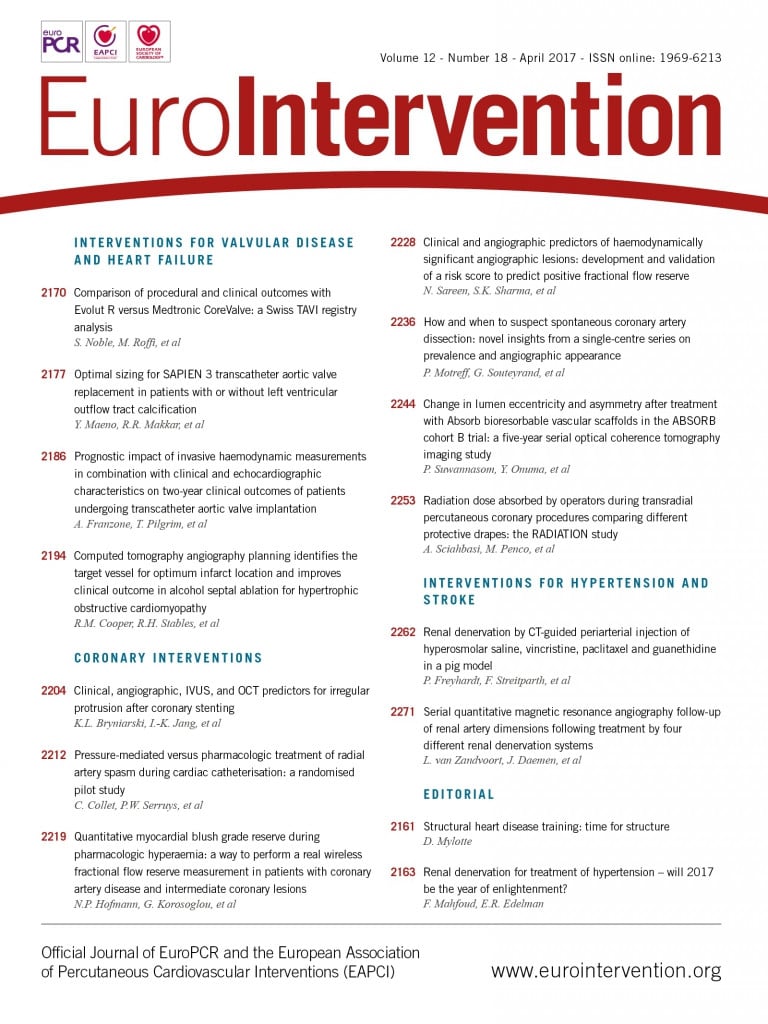
When a young cardiologist completes a dedicated fellowship in percutaneous coronary interventions (PCI), they are equipped with all of the theoretical and practical skills required to perform coronary interventions. While the duration and intensity of interventional fellowships vary, the EAPCI Training & Education Committee recommends two years of dedicated PCI training and provides a core curriculum and online resources with an e-platform for accreditation1. In most cases, PCI fellowships afford trainees the opportunity to perform an adequate number of first operator cases (>250) to develop their practical skills with mentor assistance when a difficulty arises. A variety of clinical presentations (STEMI, cardiogenic shock), anatomical subsets (left main, bifurcation), and adjunctive technologies (optical coherence tomography [OCT], intravascular ultrasound fractional flow reserve [IVUS FFR], and rotational atherectomy [RA]) is encountered during training. Further educative opportunities such as Journal Club, case conferences, and clinical research afford the PCI trainee a holistic and complete training experience. The PCI trainee is ready to hit the ground running upon completion of the coronary fellowship.
Structural heart disease (SHD) intervention has emerged as a new and important field over the last decade, encompassing a broad range of techniques, including transcatheter aortic valve implantation (TAVI), mitral valvuloplasty and repair, left atrial appendage closure, alcohol septal ablation, and paravalvular leak closure. Frequently, SHD practitioners also perform congenital heart and peripheral interventions. Taken together, these distinct procedures require specific proficiency and skills which are additional to coronary intervention. Multimodal cardiac imaging plays a central role in patient and device selection, before and during SHD interventions, and familiarisation with 2- and 3-dimensional imaging methods (transthoracic, transoesophageal, and intracardiac echocardiography, fluoroscopy, and multislice computed tomography [MSCT]) is mandatory for the practitioner.
In this issue of EuroIntervention, the breadth of SHD interventions and the importance of adjunctive imaging are clearly illustrated. Noble and colleagues2 report a comparative safety and efficacy analysis between the CoreValve classic and CoreValve Evolut™ R systems (Medtronic, Dublin, Ireland) from the Swiss TAVI registry, while Maeno et al3 detail the importance of left ventricular outflow tract calcification assessment when sizing the Edwards SAPIEN 3 valve (Edwards Lifesciences, Irvine, CA, USA). Cooper et al4 also suggest a new role for MSCT planning of guiding alcohol septal ablation for hypertrophic obstructive cardiomyopathy.
Given the rapid expansion of SHD intervention in day-to-day clinical practice, we must ensure that the interventional cardiologists of the future have the opportunity to develop skills in this rapidly expanding field. While many European institutions already offer SHD intervention programmes, fellowship training can be of inconsistent quality due to variable case volume, insufficient exposure to particular techniques or devices, the absence of dedicated imaging training, and variable patient contact and involvement in pre- and post-procedural care. Such fellowships are usually offered upon completion of coronary training, when catheter skills have been mastered, and are of one to two years in duration. Importantly, there is no standardised curriculum for training in SHD intervention. The prolongation of traditional interventional training must have a considerable impact on young practitioners and their families, their financial status, and, not surprisingly, there are anecdotally few female trainees.
Furthermore, it can be debated whether completion of an SHD fellowship truly equips the young practitioner for stand-alone clinical practice in a similar fashion to a coronary fellowship. Formal surveys of European and North American interventional communities have highlighted the significant challenges in providing comprehensive SHD training, including the limited availability of training positions, unclear application and acceptance criteria, the lack of funding for the trainee, and the absence of accreditation upon completion5-7. Similar challenges were identified in a recent survey of young imaging cardiologists when questioned on the development of “interventional imaging” as a discrete subspecialty in cardiology8. More practical concerns relate to the proof of competence with a particular procedure or device. Using TAVI as an example, how many first and second operator TAVI procedures should a trainee perform? How many valve systems should the trainee use? How many MSCT assessments are required for proficiency? How is competence assessed? Moreover, how do we assess the fellowship programme itself and its ability to deliver a comprehensive education to trainees?
In 2010, a consensus document outlining the theoretical and practical skills required for SHD trainees was published9, but the rapid pace of development in the field has already rendered this effort outdated. There is clearly a great need for a contemporary standardised curriculum for SHD trainees, trainers, and training institutions. The development of these standards should be considered a matter of urgency. Early-career cardiologists should play a leading role in the development of this curriculum through the New Initiatives for Young Interventionalists (NIFYI) Committee of the EAPCI in collaboration with the EAPCI Fellowship Committee. The tremendous resources of the family of PCR courses (EuroPCR; PCR London Valves; PCR-CIT China Chengdu Valves; PCR Tokyo Valves), PCRonline (recorded live cases, mobile apps, and textbooks), and EuroIntervention (research and review articles, Tools and Techniques, How should I treat?) should be leveraged in the development of dedicated training modules. Such resources would complement the training programmes provided by the medical device industry on their particular products. Crucially, minimal case volume for accreditation for all SHD procedures should be clearly defined and SHD programmes should be certified on their capacity to deliver the theoretical and practical skills required by trainees. Dedicated SHD research programmes are also desirable.
In this year, the 40th anniversary of coronary intervention, we find ourselves in a golden era for SHD intervention. Several SHD therapies have already become or are rapidly becoming the dominant treatment strategies in their respective fields. It is therefore incumbent on us to maintain a legacy of education and mentoring, to influence the next generation to improve our field, and ensure the quality of SHD practitioners of the future. The development of a dedicated educative programme for SHD intervention continues our rich heritage, bequeathed by Gruentzig some 40 years ago.

